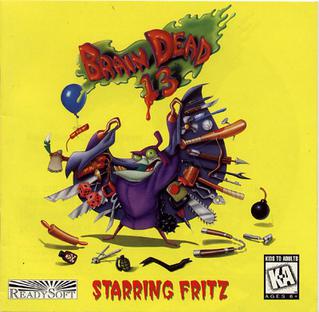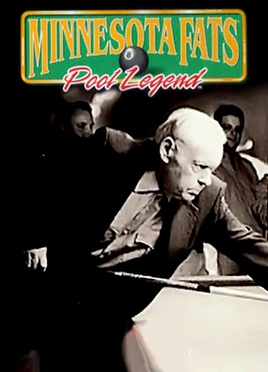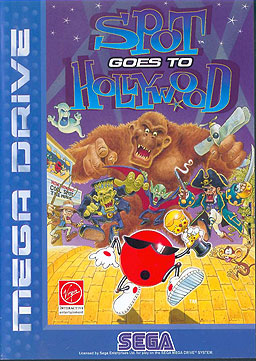
Area 51 is a light gun arcade game released by Atari Games in 1995. It takes its name from the military facility. The plot of the game involves the player taking part in a Strategic Tactical Advanced Alien Response (STAAR) military incursion to prevent aliens, known as the Kronn, and alien-created zombies from taking over the Area 51 military facility.

Primal Rage is a fighting game developed and released by Atari Games to arcades in 1994. The game takes place on a post-apocalyptic version of Earth called "Urth". Players control one of seven large beasts that battle each other to determine the planet's fate. Matches feature many of the conventions of fighting games from the era, including special moves and gory finishing maneuvers. Ports were released for home consoles and personal computers. Efforts to perfectly emulate the arcade original have been unsuccessful due to the use of an unusual copy protection method. Toys, comics, a novel and other merchandise tie-ins were produced. The game sold more than 1.5 million copies.

Brain Dead 13 is an interactive movie video game developed and originally published in North America by ReadySoft on 15 December 1995 and in Europe by Empire Interactive on the same year for MS-DOS. Unlike Dragon's Lair and Space Ace, which began as laserdisc arcade games, it was only released for personal computers and video game consoles. In the game, players assume the role of young computer expert Lance Galahad to defeat Dr. Nero Neurosis at his castle and its residents. Its gameplay is primarily presented through the use of full-motion video (FMV).

Magic Carpet is a 3D flying video game developed by Bullfrog Productions and published by Electronic Arts in 1994. Its graphics and gameplay were considered innovative and technically impressive at the time of its release.

Corpse Killer is a horror-themed rail shooter developed and published by Digital Pictures for the Sega CD, Sega CD 32X, 3DO, Sega Saturn, Windows 95 and Macintosh computers. An interactive variation on the zombie film genre, it utilizes live-action full motion video in a format similar to other games developed by Digital Pictures. Reviews for the game were mixed, generally criticizing the repetitive gameplay and low video quality, though many reviewers enjoyed the campy nature of the cutscenes. Corpse Killer was the first CD game released for the Sega 32X. It was later remastered for Steam, PlayStation 4 and Nintendo Switch.

Batman Forever: The Arcade Game is a beat 'em up video game based on the movie Batman Forever. The subtitle is used to differentiate it from Batman Forever, another beat 'em up published by Acclaim at around the same time. One or two players, playing as Batman and Robin, fight Two-Face, the Riddler, and numerous henchmen.

Quarterback Attack with Mike Ditka is a 1995 football video game published by Digital Pictures for the Sega Saturn, 3DO and MS-DOS. It features Mike Ditka as head coach of the player's team. Unlike in most football video games, the player does not control an entire team. Instead, Quarterback Attack attempts to simulate the experience of being a professional quarterback, with the other players rendered in full motion video (FMV). This break with convention divided critical response to the game.

Minnesota Fats: Pool Legend, released in Japan as Side Pocket 2: Legend of Hustler is a pocket billiards video game for the Sega Genesis and Sega Saturn, featuring famed billiards player Rudolf "Minnesota Fats" Wanderone. It was released as a sequel to Data East's earlier success Side Pocket. The objective is to travel through different cities and defeat AI-controlled hustlers. The player can also take on another human player in order to prove his worthiness at the pool table.

Road & Track Presents: The Need for Speed is a racing video game developed by EA Canada, originally known as Pioneer Productions, and published by Electronic Arts, released for the 3DO in 1994, and ported to MS-DOS in 1995. Another version of the game, The Need for Speed: Special Edition, was released in 1996 for the Microsoft Windows, PlayStation, and Sega Saturn platforms. The original 3DO version offers eight sports cars, including several exotic models and Japanese imports, and tasks the player with racing in three realistic point-to-point tracks either with or without a computer opponent. Subsequent ports of the game normally include an additional ninth car and have more tracks, including closed circuits. Checkpoints, traffic vehicles, and police pursuits commonly appear in the races.

Spot Goes to Hollywood is a platforming video game developed by Eurocom and published by Acclaim Entertainment in North America and Virgin Interactive Entertainment in Europe for the Mega Drive/Genesis as the sequel to Cool Spot. A Sega Saturn and PlayStation version was later released, and featured FMV clips and different levels but similar gameplay to the original version. It utilizes an isometric graphics system to provide a pseudo-3D playing experience. The player controls Spot, once the mascot for the 7 Up soft drink, as he travels to various places trying to free his friends. A 32X version of the game was in development but never released.

Creature Shock is a 1994 sci-fi first-person crawler game released for MS-DOS and 3DO. It was developed by Argonaut Games and published by Virgin Interactive. The game was later ported to the CD-i, Sega Saturn and PlayStation video game systems.

Arcade's Greatest Hits: The Atari Collection 1 is a compilation of Atari arcade games for the Sega Saturn, PlayStation, and Super Nintendo Entertainment System. It is a successor volume to Williams Arcade's Greatest Hits. Most of these games fall into the action game category. The Saturn and PlayStation versions of the game include an FMV documentary on the "Golden Age of Atari", featuring video interviews with the programmers behind the six games in the compilation. The later Super NES version was announced by Midway as their final release for any "16-bit" console.

Defcon 5 is a single player adventure/first-person shooter video game developed by Millennium Interactive Ltd, a UK-based studio. It was released for MS-DOS in 1995, and ported to PlayStation, Sega Saturn and 3DO Interactive Multiplayer in 1996. The name refers to the condition used to designate normal peacetime military readiness under the DEFCON system, but which is commonly misused in popular fiction to indicate a state of emergency. The game was originally announced under the title Incoming.

Krazy Ivan is a mecha first-person shooter released for PC, Sega Saturn and PlayStation in 1996 by Psygnosis.

Supreme Warrior is a full-motion video (FMV) beat 'em up game developed by Digital Pictures. It was released for the 3DO Interactive Multiplayer and Sega CD in November 1994 in North America and in early 1995 in Europe, with subsequent releases in 1995 for the 32X, Macintosh, and Windows. The game is themed as a kung fu film where the player has to fight off opponents to protect half of a magical mask.

FIFA Soccer 96 is a football simulation video game developed by Extended Play Productions and released by Electronic Arts in 1995. It was released for the Mega Drive/Genesis, Sega Saturn, Sega 32X, Game Gear, PlayStation, Super Nintendo Entertainment System, and MS-DOS compatible operating systems.

Road Rash is a 1994 racing and vehicular combat video game originally published by Electronic Arts (EA) for the 3DO Interactive Multiplayer. A version for the Sega CD was developed simultaneously and released in 1995 to act as a "bridge" between the 3DO version and the Sega Genesis title Road Rash 3, and the game was subsequently ported to the PlayStation, Sega Saturn and Microsoft Windows in 1996. The game is the third installment in the Road Rash series, and is centered around a series of motorcycle races throughout California that the player must win to advance to higher-difficulty races, while engaging in unarmed and armed combat to hinder the other racers.

















